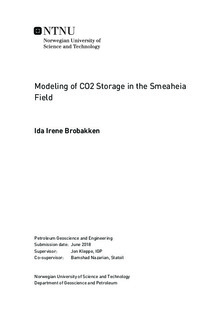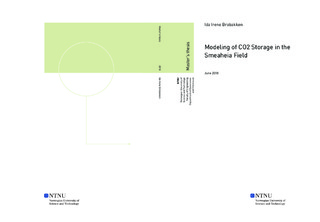| dc.description.abstract | Carbon capture and storage, CCS, is a method that can reduce today s carbon emissions by approximately 20 %. Since the world still highly depends on the use of fossil fuel energy, this method is necessary for reaching the world s 2 °C goal. This master thesis describes the CCS technology in total, including capture, transport and storage of carbon dioxide.
Smeaheia is a new Norwegian full-scale CCS project planned to be in operation in 2022. The storage site consists of two important structures, Alpha and Beta, which both can store about 100 Mt of CO2. However, the Alpha structure is found to be the best alternative as the Beta area may cause vertical CO2 migration up to the surface. Further, a reservoir simulation model of the Smeaheia area has been developed by Equinor. The model is used for different studies in this thesis, including simulations of injection well locations, perforation depths and the use of outflow control devices. Comparisons of different well designs are completed to find the optimal alternative maximizing the CO2 storage.
The optimal well location found within the Alpha structure has a storage capacity of 135 Mt CO2 in total when CO2 is being injected for 25 years. This well is located in the northern part of Alpha, far away from the leaking Beta area. The best alternative outside the Alpha structure is found to be in the southern part of the reservoir model. Two injection wells with each an annual rate of 100 Mt of CO2 will result in a total storage volume of 5000 Mt after 25 years. Further, it is seen that perforations made in the lower part of the Fensfjord and Krossfjord formations will maximize the storage capacity.
The effect of outflow control devices is studied in high-permeable and low-permeable layers. Results show that such a control device has better effect in high-permeable zones. At last, the injected CO2 is tracked during the simulation. The carbon dioxide will migrate within the Alpha structure and between the Alpha and Beta areas as time goes by and as the Alpha structure is being filled up to its spill point. | en |

